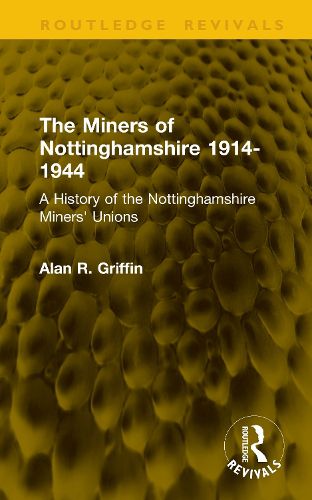Readings Newsletter
Become a Readings Member to make your shopping experience even easier.
Sign in or sign up for free!
You’re not far away from qualifying for FREE standard shipping within Australia
You’ve qualified for FREE standard shipping within Australia
The cart is loading…






Originally published in 1962, this is an important work in the history of Trade Unionism. The period covered by this volume saw momentous changes in the structure of trade unionism in the mining industry in England. In 1914 every coalfield had its own District Union. These district unions were bound together into a loose Federation. During the war years the locus of power shifted from the district associations to the national Federation. Internal arguments in the Federation based on economic and ideological grounds took place during the 1920s.
A grass-roots study, this book shows why non-political trade unionism took hold in the Nottinghamshire coalfield but failed elsewhere. The importance of the Nottinghamshire pits was their economic position, which was favourable in comparison to other mines. The book examines the character and decision-making of the people who shaped the destiny of the miners in the 1920s and 30s and discusses the difficult period from 1926-1937 when the old Nottinghamshire Miners' Association was ignored by the coal-owners. The merits of district settlements which would enable the Nottinghamshire miners to maintain their relatively high wages, compared with national settlements which would tend to depress wages in the more highly paid counties are also analysed.
The book will be of interest to economic and industrial historians, and students of industrial relations.
$9.00 standard shipping within Australia
FREE standard shipping within Australia for orders over $100.00
Express & International shipping calculated at checkout
Stock availability can be subject to change without notice. We recommend calling the shop or contacting our online team to check availability of low stock items. Please see our Shopping Online page for more details.
Originally published in 1962, this is an important work in the history of Trade Unionism. The period covered by this volume saw momentous changes in the structure of trade unionism in the mining industry in England. In 1914 every coalfield had its own District Union. These district unions were bound together into a loose Federation. During the war years the locus of power shifted from the district associations to the national Federation. Internal arguments in the Federation based on economic and ideological grounds took place during the 1920s.
A grass-roots study, this book shows why non-political trade unionism took hold in the Nottinghamshire coalfield but failed elsewhere. The importance of the Nottinghamshire pits was their economic position, which was favourable in comparison to other mines. The book examines the character and decision-making of the people who shaped the destiny of the miners in the 1920s and 30s and discusses the difficult period from 1926-1937 when the old Nottinghamshire Miners' Association was ignored by the coal-owners. The merits of district settlements which would enable the Nottinghamshire miners to maintain their relatively high wages, compared with national settlements which would tend to depress wages in the more highly paid counties are also analysed.
The book will be of interest to economic and industrial historians, and students of industrial relations.